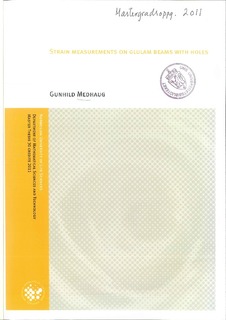| dc.contributor.author | Medhaug, Gunhild | |
| dc.date.accessioned | 2012-05-18T12:23:27Z | |
| dc.date.available | 2012-05-18T12:23:27Z | |
| dc.date.issued | 2012-05-18 | |
| dc.identifier.uri | http://hdl.handle.net/11250/188694 | |
| dc.description.abstract | The starting point of this study was the situation for Norwegian engineers lacking trustworthy design rules for glulam beams with holes. The Norwegian design code for timber (NS 1999), provide design recommendations based on Johanneson’s “Shear-stress” method described above. The “Shear-stress” method is an ultimate limit state shear control of the residual cross-section of the beam. Bending moment effects are not considered. The geometry criteria in themselves are so conservative that the practical accomplishment of introducing a hole in a glulam beam is difficult. Further, the contemporary version of the European timber code Eurocode 5 (1995-1-1 2004) contains no design recommendations for beams with holes. Even though there have been significant improvements in modeling the load carrying capacities the last years, there is still indication of the need for more research and experimental verification. In earlier research, the stress concentrations in the vicinity of the hole have been modeled, and load carrying predictions have been estimated by proposed design models. The actual stress values are however calculated by means of Finite Element Models and material properties are found from other sources. | no_NO |
| dc.language.iso | eng | no_NO |
| dc.publisher | Norwegian University of Life Sciences, Ås | |
| dc.subject | glulam beams | no_NO |
| dc.subject | shear-stress | no_NO |
| dc.subject | measurements | no_NO |
| dc.title | Strain measurements on glulam beams with holes | no_NO |
| dc.type | Master thesis | no_NO |
| dc.subject.nsi | VDP::Technology: 500::Building technology: 530::Construction technology: 533 | no_NO |
| dc.source.pagenumber | 60 | no_NO |
